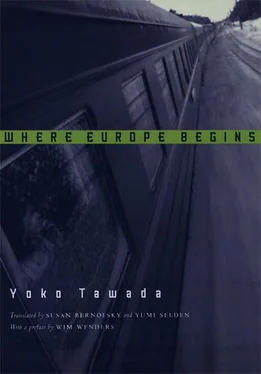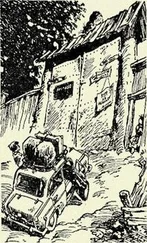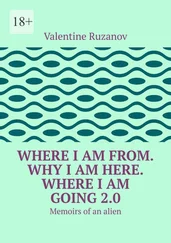STORYTELLERS WITHOUT SOULS
1
One of the German words I’ve become more and more attached to in recent years is the word Zelle , or “cell.” This word lets me imagine a large number of tiny spaces alive within my body. Each space contains a voice that is telling a story. For this reason these cells can be compared to cells of other sorts: telephone booths, and the spaces inhabited by prisoners and monks.
It’s beautiful when a phone booth is lit up at night on a dark street. In the section of Tokyo where I grew up, there was a park full of ginkgo trees. In one corner of the park stood a phone booth that was very popular with young girls. From dusk to midnight it was continuously occupied. Probably the girls could develop their talent for telling stories better in this cell than at home with their parents. They gripped the receiver firmly and glanced around with lively, empty eyes, as if they could see the person they were talking to somewhere in the air. The transparent glass box, lit from within, where the girls spent so much time stood between the dark shapes of the trees in the park: this image fascinated me even then, when I myself was a girl. But the subject matter of the girls’ conversations was of little interest. They spoke mostly about the males with whom they had relationships. Sometimes the phone booth resembled a transparent tree occupied by a tree spirit. The Japanese fairy tale “The Bamboo Princess” begins with an old man seeing a luminous bamboo trunk and chopping it down. Inside he discovers a newborn baby girl that he raises together with his wife. The tale ends with the girl, who has become a grown woman, flying back to where she really comes from: the moon.
The nocturnal phone booth might also have been a spaceship that has just landed in the park. The moon men have sent a moon girl to Earth to inform them about our life. The girl is just making her first report. What would she say about the park? Would she have much to report so soon after her arrival?
Later, in Austria, I saw a cell that immediately reminded me of the phone booth. It was made of solid wood and stood in the unlit corner of a Catholic church. The walls of the cell radiated warmth and calm; right away I thought I would be just as happy to stand inside telling stories as the girls in the phone booth. A friend told me the cell was called a “confessional” and that, like the nocturnal phone booth, it was a place to talk about sexual encounters. But unlike a modern phone booth, the confessional was made of wood and stood there like a tree whose roots have grown deep into the earth. It couldn’t fly away like a spaceship. So there are storytelling cells that stay in one place, and others that appear to be mobile.
And so I understood why a chamber that resembles a prison cell is better suited for composing an erotic text than a large room in which optical sensuality is staged. I don’t think much of asceticism, nor do I believe that sensual pleasure can enter a piece of writing only when it is suppressed in real life. The claim that a person who writes is not truly living can be made only by someone who sees a person and his life as subject and object. He might say the most important thing is to live one’s life. I would say: I live, and my life lives as well. Even my writing lives. Thus the question of whether a person is living when he writes is misguided to begin with. One asks this sort of question only to make everything revolve around man.
It doesn’t have anything to do with asceticism when someone sits in a cell and writes. It has much more to do with the activation of the living cells that comprise their own phone booths, monks’ cells and prison cells within the body. Countless stories are told in these enclosed spaces. When I write, I try to hear the stories coming from within my body. When I listen, I realize how unfamiliar my own cells are to me. They consist of what I have inherited and what I have eaten. Thus it often happens that a story I hear within my body seems to me chronologically or geographically distant.
But can one understand the language of cells at all? The question brings to mind the image of yet another cell: the booth for simultaneous interpreters. At international congresses you often see these beautiful transparent booths in which people stand telling stories: they translate, so actually they are retelling tales that already exist. The lip movements and gestures of each interpreter and the way each of them glances about as she speaks are so various it’s difficult to believe they are all translating a single, shared text. And perhaps it isn’t really a single, shared text after all, perhaps the translators, by translating, demonstrate that this text is really many texts at once. The human body, too, contains many booths in which translations are made. I suspect that these are all translations for which no original exists. There are people, though, who assume that everyone is given an original text at birth. They call the place in which these texts are stored a soul.
2
In Hamburg-on-the-Elbe there is a small harbor known as Devil’s Bridge. A long time ago, no one was able to build a bridge across the Elbe strong enough to withstand a severe autumn storm. The devil made the desperate Hamburg merchants an offer: he would build an indestructible bridge. In payment he demanded a soul. The merchants promised to give him a soul when the bridge was completed. When the devil had finished work, it became apparent that none of the merchants was prepared to forfeit his soul, and so they sent a rat across the bridge to the devil, who stamped on the rat in fury and then sank into the earth. Since then the harbor has been called Devil’s Bridge.
When I first heard this legend, I didn’t understand it, because I didn’t know rats have no souls. That is, rats have no souls for the devil, who is quite Christian in his orientation. In other religions that tell of the lives of plant souls and animal souls, a rat most certainly does have a soul — one every bit as precious as that of a Hamburg merchant. The devil needn’t have been disappointed.
I have two ways of visualizing the human soul. In the first, the soul looks like an elongated roll I once ate in Tübingen. This sort of bread is called Seele or “soul” in Swabia, and many people have souls in this shape. But this doesn’t mean the soul is inserted into their bodies like a roll. The soul is an empty space in the body that must constantly be filled with the roll that has the same shape as this space, or with an embryo, or with the breath of love. Otherwise the owners of the souls feel as if something is missing.
The second way I picture the soul is as a fish whose name is also “sole”: thus the soul is related to water, or to the sea. I’m thinking of something like the soul of a shaman. Among the Tungus, for example, it’s said the soul of the aspiring shaman draws the tribal river down to the dwelling place of the shaman’s ancestral spirits. There, among the roots of the tribe’s shamanic tree, lies the shaman’s animal mother, who devours the soul of the new arrival and then gives birth to it in the form of an animal. This animal can be a quadruped, or it can be a bird or a fish; in any case, it functions as the shaman’s double and guardian spirit.
It’s a nice thought that somewhere in the world the soul is leading its own life in animal form. The soul is independent from the person in question. The human being has no way of knowing what the soul is experiencing, but still there is a link between him and his soul. I would like to share a life with the person I call “my soul” as the shaman does with his; I never see or speak with this person, but everything I experience and write corresponds to this person’s life. I appear to be soulless because my soul is constantly in transit.
Читать дальше












